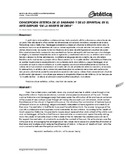| dc.rights.license | http://creativecommons.org/licenses/by-nc-sa/3.0/ve/ | |
| dc.contributor.author | Barrera, Claudia | |
| dc.date.accessioned | 2009-07-21T17:46:57Z | |
| dc.date.available | 2009-07-21T17:46:57Z | |
| dc.date.issued | 2009-07-21T17:46:57Z | |
| dc.identifier.issn | Revs-0002 | es_VE |
| dc.identifier.uri | http://www.saber.ula.ve/handle/123456789/29026 | |
| dc.description.abstract | A partir de la visión estética contemporánea, todo producto artístico alcanza su valor a través de un juicio. Más allá de esta crítica existen las dimensiones emocional, simbólica y expresiva de la obra. Pensadores como Nietzsche y Heidegger ponderan sus ideas en virtud de la afirmación de la vida y la existencia humana en el derrotero de nuevos valores espirituales a través del arte, tomando en cuenta dichas dimensiones, las cuales incitan la influencia de la obra de arte figurada en voluntad de poder. Esta voluntad permite la conjunción de características típicas del espíritu del hombre como la mitología, la religión y la realidad interpretadas en la imaginación y creatividad del mismo. La estética en sí misma tiende a rebasar los límites establecidos, manifestar el lenguaje del alma dentro de una atmósfera filosófica en la cual
recrea su propia crítica. De acuerdo con “la muerte de Dios” difundida por Nietzsche, es posible inquirir sobre la representación y el contenido de la obra artística y, según Heidegger, en el momento en que la obra manifiesta un mundo sagrado, se abre el ente enalteciendo al hombre, los valores de la humanidad se exteriorizan en medio del vínculo establecido entre la creación y el ser-obra. En este sentido, la estética de la valoración permite evaluar el contenido de la obra, esta estimación remueve la voluntad de poder favoreciendo la aparición de nuevos valores (transvaloración) en virtud de la afirmación del devenir y lo múltiple que reduce la aniquilante influencia del nihilismo. En los tiempos de “la muerte de Dios”, el arte es el principal conector entre lo espiritual y lo material. | es_VE |
| dc.language.iso | es | es_VE |
| dc.rights | info:eu-repo/semantics/openAccess | |
| dc.subject | Estética | es_VE |
| dc.subject | Crítica | es_VE |
| dc.subject | Voluntad de poder | es_VE |
| dc.subject | Ser | es_VE |
| dc.title | Concepción estética de lo sagrado y de lo espiritual en el arte después “de la muerte de dios” | es_VE |
| dc.type | info:eu-repo/semantics/article | |
| dc.description.abstract1 | From the contemporary aesthetic vision, any product reaches its artistic value through a trial. Beyond this criticism there are emotional, symbolic and expressive dimensions of the work. Thinkers such as Nietzsche and Heidegger weigh their ideas under the affirmation of life and human existence in the course of new spiritual values through art, taking into account such dimensions, which incited the influence of the artwork in Figured will to power. This will allows the combination of features typical of the spirit of man as mythology, religion and reality interpreted in the imagination and creativity of the same. The aesthetics in itself tends to exceed the established limits, the express language of the soul into a philosophical atmosphere in which recreates his own criticism. According to the “death of God” spread by Nietzsche, it is possible to inquire about representation and content of the artistic work and, as Heidegger, at the time that the work demonstrates a sacred world, opens the entity raising man, the values of humanity shown in the middle of the link between the creation and work-be. In this regard, the aesthetics of valuation to evaluate the content of the work, this estimate removes the will to power by encouraging the emergence of new values (transvaloración) under the affirmation of the future and multiple which reduces the influence of nihilism. In the era of “death of God”, art is the main connector between the spiritual and the material. | es_VE |
| dc.description.colacion | 41-53 | es_VE |
| dc.description.email | claudiabarrera@hotmail.com | es_VE |
| dc.description.frecuencia | semestral | es_VE |
| dc.identifier.depositolegal | 199702ME179 | es_VE |
| dc.subject.centroinvestigacion | Centro de Investigaciones Estéticas (CIE) | es_VE |
| dc.subject.facultad | Facultad de Humanidades y Educación | es_VE |
| dc.subject.keywords | Aesthetics | es_VE |
| dc.subject.keywords | Criticism | es_VE |
| dc.subject.keywords | Will to power | es_VE |
| dc.subject.keywords | Being | es_VE |
| dc.subject.publicacionelectronica | Revista Estética | es_VE |
| dc.subject.thematiccategory | Artes y Humanidades | es_VE |
| dc.subject.tipo | Revistas | es_VE |
| dc.type.media | Texto | es_VE |



